The MSI Prestige 14 Evo Review: Testing The Waters Of Tiger Lake
by Brett Howse on December 17, 2020 10:00 AM EST- Posted in
- Laptops
- Intel
- MSI
- Tiger Lake
- Notebook
Display Analysis
As the name suggests, the MSI Prestige 14 Evo features a 14-inch display, and MSI has gone with the more standard 1920x1080 IPS panel, meaning a 16:9 aspect ratio. That is somewhat disappointing, as competing laptops have started to transition to taller displays in the 16:10 and 3:2 range.
The laptop offers no touch support either, so this is as traditional of a clamshell Ultrabook as you can get. Some may not like touch, but for a wider audience, having a feature and not using it is better than not having it at all.
 Sub-pixel arrangement. The haze is the matte coating on the display.
Sub-pixel arrangement. The haze is the matte coating on the display.
The 1920x1080 resolution in this screen size means the laptop offers 157 pixels-per-inch in terms of display density. There is always a tradeoff for density versus battery life, and although 157 is pretty far from what you would consider a high DPI panel, it still works well in this form factor. Out of the box, Windows sets this to 150% scaling, although you can of course adjust if you want more real estate. 125% seems to work pretty well. There is no UHD display option, but as we have seen in other devices which offer UHD, the hit to battery life is significant, so sticking with a more traditional 1920x1080 resolution still makes sense.
The display targets sRGB, and although some competing devices may offer P3 or Adobe RGB gamut support, the lack of a system-wide color management system in Windows still unfortunately means sRGB is better for most people. If you use professional applications that can correctly manage color, the MSI Prestige is likely not for you, but for the average consumer using content that is likely over 99% of the time targeting sRGB, MSI has made the right choice here.
To see how the MSI Prestige 14 Evo fares in terms of color accuracy and contrast, we have run it through a custom workflow in Portrait Display’s Calman suite, using the X-Rite i1Display Pro colorimeter for brightness and contrast measurements, and the X-Rite i1Pro 2 spectrophotometer for color accuracy readings.
Brightness and Contrast
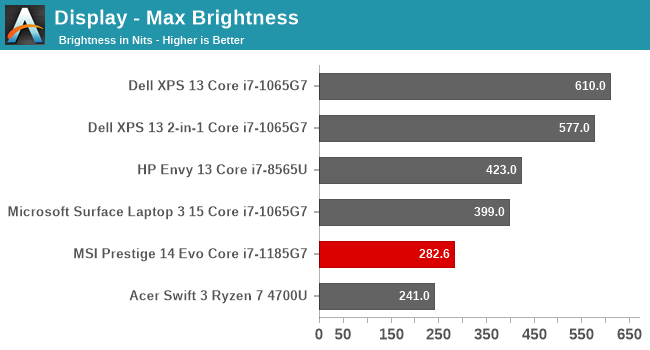
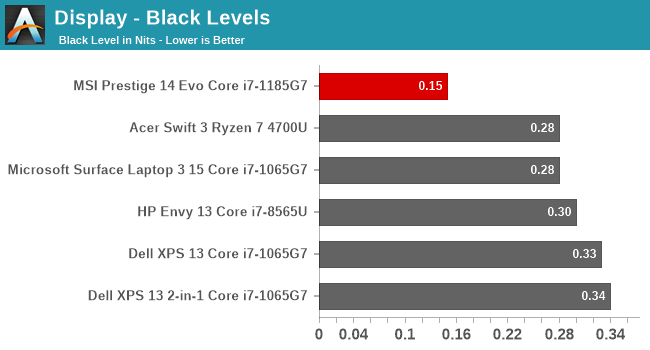
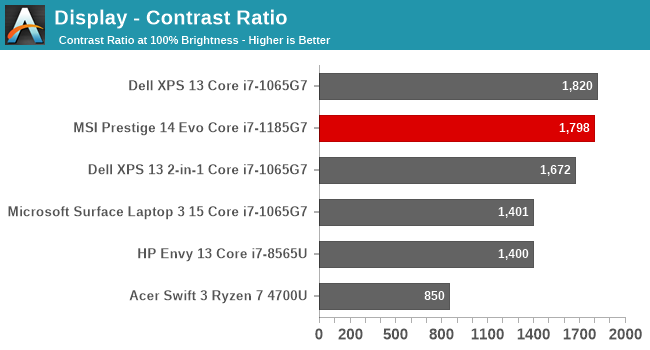
The Prestige 14 gets off to a good start in terms of display contrast, almost hitting 1800:1. The panel offers excellent black levels which help it achieve this result. It does not get overly bright though, not even hitting 300 nits at 100% brightness, and would likely struggle outdoors because of that. It does get very dim though for use in a dark room with the display going all the way down to 5 nits.
Grayscale
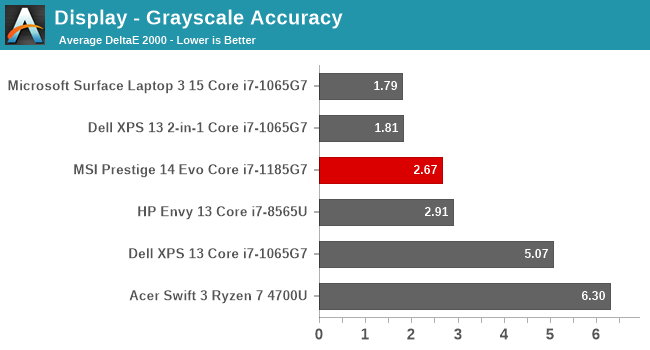
MSI has done a very good job on the default color profile for this laptop, with the grayscale averaging under the 3.0 level that we’d consider to be a good display. There are a couple of peaks slightly over, but nothing too dramatic. The color balance across the gray range is very consistent, with blue dropping slightly compared to red and green, but overall still doing very well.
Gamut
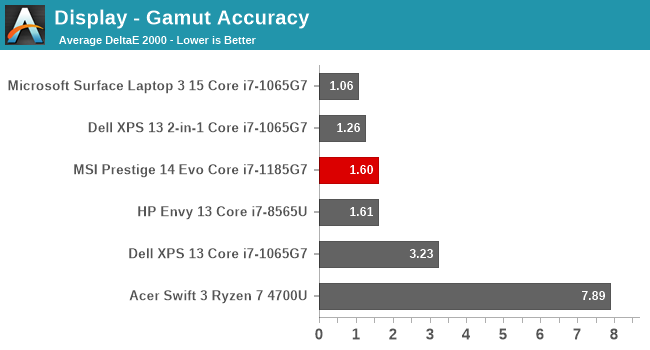
The good news continues when looking at the sRGB gamut coverage. The laptop is able to hit all of the major color points for primary and secondary colors with very little error.
Saturation
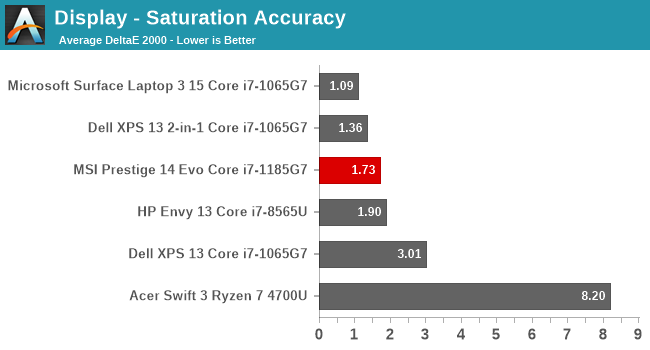
The saturation sweep does the same color targets as the gamut test, but across the entire range from 0% to 100% brightness on each primary and secondary color, tested at 4-bit intervals. None of the colors show any real error rates above the 3.0 mark, with most well under across the entire range. Clearly, MSI has done their homework and calibrated the display at the factor to achieve these levels of accuracy. There is no ICC profile included as the error correction is being done in hardware.
Gretag Macbeth
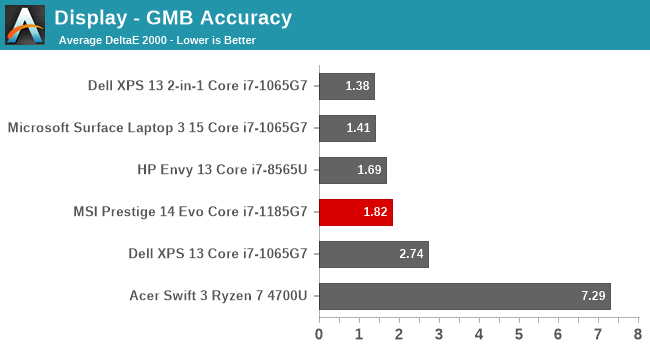
While the previous tests focus on primary and secondary colors, the Gretag Macbeth tests a much wider range of colors, including the important skin tones. Once again, the MSI Prestige 14 performs very well here, with only a couple of individual colors above the 3.0 error level, and only just. MSI has done a great job calibrating this display.
Colorchecker
While the previous graphs show error rates, the final image is the colorchecker swatch, which shows the target color on the bottom, and the achieved color by the display on the top. This gives you a better relative look at the error rate. Again, it shows the accuracy of this display.
Display Conclusion
Although the MSI Prestige 14 Evo is a mostly standard 1920x1080 16:9 display, and it just targets sRGB, MSI has done the added work to calibrate the display at the factory, which vastly improves its accuracy. Some devices use an ICC profile to fix the calibration through software, but ICC profiles can be a challenge especially if the application ignores them, so doing this through hardware is a better solution. The combination of high contrast and high accuracy make this one of the better displays available in this category.



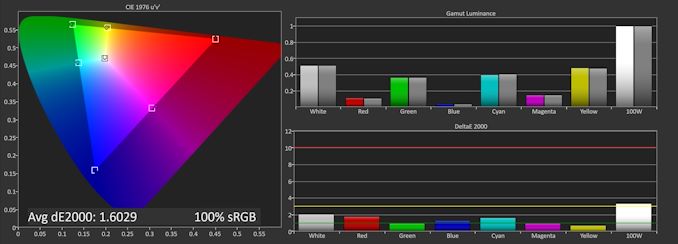

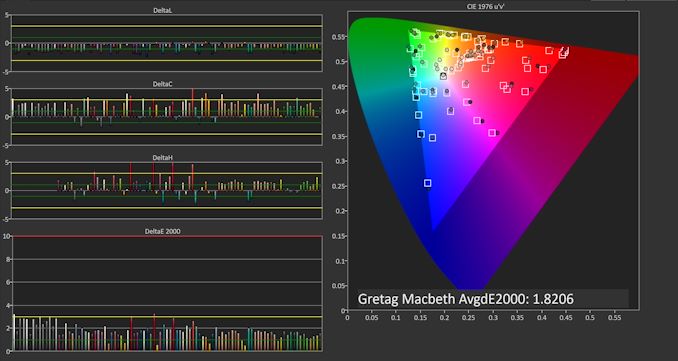









63 Comments
View All Comments
Spunjji - Friday, December 18, 2020 - link
I can accept this rationale on a device that has 2 or 3 USB 3 A ports along with the USB 2 port, but when it's the only USB A port on the device it's a poor showing. It's a bit premature to refer to any storage device not using USB-C as "legacy".Deicidium369 - Thursday, December 17, 2020 - link
Not like you would REALLY be a customer ...tipoo - Thursday, December 17, 2020 - link
Any impressions on how the Intel publicized Ryzen 10 second boost delay on battery impacts real world system responsiveness?Smell This - Thursday, December 17, 2020 - link
**The CPU runs at an all-core turbo of 4.3 GHz initially with a peak power draw of almost 52 Watts, and then settles down to a sustained 30-Watt draw for the duration with the CPU frequency...**_________________________________________________
Would be nice if AT actually identified the X-axis title and time scale.
INCREDIBLY DISAPPOINTED on how this has been presented.
Brett Howse - Thursday, December 17, 2020 - link
In what has been a difficult year for everyone, I can see how this lapse in my judgement has hurt significantly. I apologize, and have updated the offending table.lmcd - Friday, December 18, 2020 - link
This travesty will likely shake the earth to its core. Next earthquake's on you bud ;)Smell This - Friday, December 18, 2020 - link
Thanks, BrettNo worries, Mate
henkhilti - Thursday, December 17, 2020 - link
Looks like 36W sustained to me, not 30W.phoenix_rizzen - Thursday, December 17, 2020 - link
So Intel's top-of-the-line Tiger Lake CPU trades blows with AMD's second-best, last-gen APU. Not sure if I should be impressed with how well AMD is doing these days, or depressed by how far Intel has fallen. It should be worrying to Intel's marketing team that a low-end brand like Acer Swift can compete so well with a top-end EVO-branded laptop. Wonder how they're going to spin that?It's nice to see actual competition in the laptop space, though. AMD 4000-series APUs, Intel Tiger Lake, AMD 5000-series APUS, Intel's next gen (forget the name). Will be an interesting 2021 for laptops. :)
yeeeeman - Thursday, December 17, 2020 - link
Where is current gen AMD APU if 4700U is last gen?4700U is still current gen until we get 5000 series products which will happen in march next year.